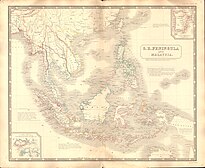Malaysians of Indonesian descent
[6][7] Negeri Sembilan, in particular, has large numbers of Minangkabau, Acehnese in Kedah, Javanese in Johor, Banjar in Perak and Bugis in Selangor and Sabah.
Malaysia's former first king Tuanku Abdul Rahman,[8] Najib Razak, and Muhyiddin Yassin, each of them have Minangkabau, Bugis, and Javanese ancestry.
Throughout their history, the borders of ancient kingdoms and empires – such as Srivijaya, Majapahit, Malacca and Johor-Riau – often comprised both modern-day countries.
The migration of Indonesian to Malaysia can be traced back since before the colonial time especially during the Srivijaya and Majapahit administration.
The first king of the Malacca Sultanate was descended from the Srivijaya prince Sang Nila Utama from Palembang.
[11] Other historical texts such as Tuhfat al-Nafis (known as Sejarah Melayu dan Bugis (History of the Malays and Bugis)), stated the relations between different Sultanates of Johor-Riau, Kedah, Perak, Selangor, Pahang, and Terengganu on the peninsula with the east and west coasts of Sumatra and Kalimantan.
[11] During the British occupation, Malaysia was integrated into the world's commodity and capital markets, became a source of resources for the colonizers (suzerain) and began to face labor shortages.
Indonesians became the third source of labor and the British viewed and treated them differently from Indians and Chinese because they were considered to have the same race as Malays.
By classifying Indonesian migrants (such as Javanese, Minangkabau, Bugis, Bawean, Banjar, Mandailing, Acehnese and others) into ethnic Malays, the government party Pertubuhan Kebangsaan Melayu Bersatu or UMNO expanded its mass base.
At the beginning of the 14th century, the Minangkabau people arrived in Negeri Sembilan via Melaka and initially settled in Rembau.
The initial migration of the Minangkabau people mostly came from the Tanah Datar and Payakumbuh areas of West Sumatra.
Therefore, the leaders of Negeri Sembilan requested that they be allowed to invite a prince from Pagaruyung (West Sumatra) to rule over them.
[14][15] The population census in Malaysia does not categorise Minangkabau as a separate ethnic group, but is generally classified as Malay.
In the 19th century, Muhammad Saleh Al-Minankabawi became the mufti of the Perak Kingdom and Uthman bin Abdullah became the first qadi in Kuala Lumpur.
In addition, Mohamed Taib bin Haji Abdul Samad, who has a fairly large business, became an explorer in the Chow Kit area in Kuala Lumpur.
The Bugis people originate from South Sulawesi and have played an important role in Malaysian history.
The conclusion in 1669 of a protracted civil war led to a diaspora of Bugis and their entry into the politics of the Sumatra and Malay Peninsula.
Both the Buginese and the Minangkabau aware how the death of Sultan Mahmud II had provided them with the chance to exert major influence in Johor.
Then with the help of the Bugis from Klang, King Sulaiman managed to seize the territory of Johor and Riau Lingga from the hands of Raja Kecil.
In return, King Sulaiman gave the title of Yang Dipertuan Muda to Daeng Marewah who ruled in Johor and Riau Lingga.
[18][19][20] In modern Malaysia, Buginese are classified as Bumiputera (like members of other historical immigrant ethnicities originating from Indonesia).
The lack of documentation and historical records has resulted in the exact time when the Baweans arrived in Malaysia.
In Melaka, the Baweans also spread to the Klang Valley, such as in the Ampang, Gombak, Balakong and Shah Alam areas.
The Acehnese, especially in Penang, have contributed a lot to economic growth through the export of their natural wealth, especially pepper.

